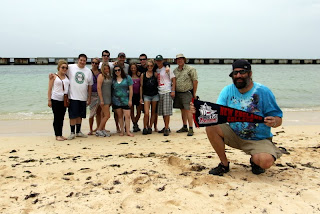Location: Zapata National Park, Zapata Peninsula
Click here to see an online album with 44 high-resolution photos from this day.
Note: I am writing this blog at 11PM on 5/17, but I expect it will be several days before it can be uploaded. There Internet at our hotel is not working, and there is no other location to access the Internet in this rural part of the country. So the uploading will have to wait a few days until we are at our next hotel.
Today was filled with explorations of the history and natural beauty of Zapata National Park, Cuba’s largest nature reserve and the largest wetlands in the Caribbean. The day was quite filled, leaving everyone satisfied and exhausted by nightfall.
As always, our bus driver Eduardo had our ride ready promptly at 9AM, and Ludwig our guide was ready and waiting for us. Ludwig and Eduardo are with us 24/7 for the entire trip. Eduardo always has the bus ready (I’ve never seen him get gas, so he must be doing it at night). Ludwig patiently answers every question and sees to all our needs, paying for all our meals and visits, and seeing to everyone’s comforts. The tour company is doing a great job.
Our first stop today was a spot in the park that allows us to view the Bee Hummingbird, one of three endemic hummingbird species in Cuba, and the world’s smallest bird. Our guide led us to a nest on a branch about 7 feet in the air. The nest was a half sphere a bit larger than a golf ball, and it houses two young hummingbirds. After a few minutes, one fly up to a higher branch. Everyone took photos and videos of these unique creatures:
Our next stop was Playa Larga, a beach that forms part of the Bay of Pigs within the park. All the students participated in a service learning project to clean the beach:
As we worked, Ludwig taught us about the Playa Giron Invasion (a/k/a Bay of Pigs Invasion) and the October Missile Crisis (a/k/a Cuban Missile Crisis). He was quite forthcoming and open, making it a fascinating exchange. Seeing the abandoned cement defensive bunkers helped bring history to life.
Our next stop was Playa Giron, the site of the invasion itself:
Although now a beach resort hotel, we were able to visualize the sites of battle. From there, we drove to the nearby Museo de Playa Giron, a museum dedicated to the invasion. Photographs and text told the story of life in Cuba before the 1959 revolution, the start of the socialist society, the invasion, and its aftermath. There were weapons from the battle on display (including mortars, machine guns, anti-aircraft batteries, tanks, and a plane) and memorials to the fallen Cuban soldiers:
It was fascinating to learn this history from a new perspective. Most surprising to me was the fact that America and Americans were mentioned only a few times. The invasion is seen as an action of Cuban exiles, launched from Central America, with the U.S playing only a minor supporting role (supplying weapons, mostly).
We drove to a small resort called Caleta Buena for lunch. After feasting on a buffet (which had a greater selection of food than we have seen in Cuba so far), we were all outfitted with snorkel gear. Most of the class had never been snorkeling before, so we taught some lessons on how to use the equipment. We found a great spot to start: a natural ocean-fed pool that was calm but rich in fish:
After getting used to snorkeling in this calm and isolated location, we all moved out into the open reef off shore. The students gamely followed me as I led them along the reef, pointing out wildlife. We saw a great variety of species, including corals (staghorn, mustard hill), sea urchins, West Indian sea eggs, sea cucumbers, and a wide variety of fish, including sergeant majors, blue tang, yellowtail damselfish, chub, parrotfish, and squirrelfish:
After a few hours of snorkeling, we all enjoyed relaxing on the beach and chatting about what we had seen.
We returned to the Playa Larga Hotel around 5:30PM, giving everyone enough time to rest up before dinner. We enjoyed a typical Cuban meal which, I admit, is starting to lose its charm a bit!
I was treated to a round of “Happy Birthday to You” along with a candle on a plate to blow out. After dinner, we worked on our journals, played games, and relaxed. When asked to name their favorite part of the day, the most common answer was snorkeling, followed by the service learning project and interacting with the local people.
All in all, it was a great day, filled with culture, history, and natural beauty. We look forward to the adventures that tomorrow will bring!
All our best from Cuba,
ejs













No comments:
Post a Comment